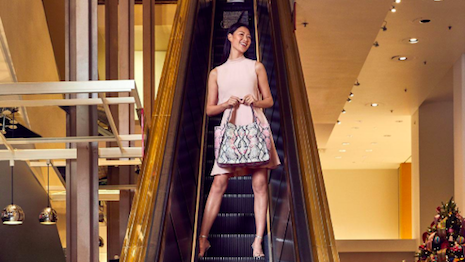NEW YORK – China’s digital ecosystem offers a hint of how the luxury retail environment will evolve in the near future.
In a discussion at Luxury FirstLook 2020 on Jan. 15, a partner from Digital Luxury Group gave an overview on how Chinese consumers can give luxury brands a preview of what is to come globally. Millennial and Generation Z shoppers account for more than 80 percent of luxury purchases in China, well ahead of the rest of the world.
“Gen Z is extra digital,” said Iris Chan, partner and international client development director at Digital Luxury Group. “Trying to get your mind around how to tackle them is overwhelming at times, but it’s a reflection of where everything will be following in years to come in other markets.”
Luxury FirstLook 2020 was produced by Luxury Daily, with venue sponsor UBS
Courting China
Digital platforms including Weibo, WeChat and Xiaohongshu – better known as Little Red Book or simply Red – dominate the landscape in China. Forms of digital marketing in the West such as WhatsApp and email are fruitless in the country.
WeChat and live-streaming are especially essential for consumers to interact and engage with one another, while Red has basically replaced search engines, according to Ms. Chan. The majority of Red’s users are Generation Z.
Luxury brands Louis Vuitton, Bulgari and Cartier successfully reach digitally savvy Chinese consumers by effectively leveraging influencer relationships and Eastern social media platforms.
According to Gartner L2’s 2019 “Digital IQ Index: Luxury China” report, luxury adoption of Chinese ecommerce stores is on the rise. Brands that are more open to flexibility and collaboration are also partnering with Chinese business-to-consumer platforms that offer large audiences and logistical support (see story).
Luxury brands looking to reach lower tier cities, which are growing in prominence, would also be wise to establish a live-streaming platform.
For instance, celebrity and entrepreneur Kim Kardashian teamed with Chinese KOL Viya for a livestream timed with Singles’ Day last year, which drew 13 million viewers. Seven percent of Alibaba’s total $38 billion in sales from Singles’ Day happened during live streams (see story).
However, the digital environment has been established in China long enough that it impacts older generations.
“The whole ecosystem in China is digital,” Ms. Chan said. “These younger generations are digital-minded, not just digitally-savvy.”
Chinese millennials, like their counterparts worldwide, are becoming parents and their consumption habits reflect this new life stage.
Bricks-and-mortar boom?
Despite the omnipresent force of technology in China, Ms. Chan insists that physical retail is still part of the overall shopping experience.
Recently, luxury brands have ramped up their bricks-and-mortar investments in China.
Late last year, U.S. jeweler Tiffany & Co. opened its first Blue Box Café restaurant in Mainland China as dining experiences gain more prominence in shopping trips.
Decked out in the trademark Tiffany Blue color, the restaurant is located on the upper level of Tiffany’s newly renovated Shanghai flagship store at the Hong Kong Plaza. The two-story Shanghai store in transparent and blue-lit glass now faces the street and has doubled its footprint to 10,000 square feet, making it the largest Tiffany store in North Asia (see story).
Harrods also followed in Galeries Lafayette's footsteps by opening a store in China. Located in Shanghai, the outpost marks the brand's first store in mainland China and its bricks-and-mortar debut outside its native U.K. (see story).
The well-established digital environment also allows brands to experiment with what Ms. Chan described as Orwellian technology, such as facial recognition.
In 2018, Alibaba opened a concept store that offered shoppers and luxury retailers a look at a new frontier for fashion retail digitization. Dubbed “FashionAI,” the pilot boutique harnessed artificial intelligence capabilities for a stress-free shopping experience, acting as a temporary testing ground for innovative retail formats (see story).
“The offline experience remains compelling,” Digital Luxury Group’s Ms. Chan said. “Brands need to tell their story in a meaningful way and it has to connect back online.”
{"ct":"WHQAaXAgogJlAagfJa1y+\/+mTfctKtUBunHtl7vg1aNdHxsCLAH1+T0NO6dBimO2D5gIA0PHini4QdX2yAfBByusX9qQudbzfFCFe2AIm2+KeoJyTshKMtE0TTe9eXXaK8SdPQsQnWcv53ojGpzpTMKIw\/fYBLnwuGPcUMeMPH7L5OsXOEQYeplP+xmdAM6OaRpKxK48Lu8\/UGgowBN+0B6ZAtqo\/DH\/EYKxBnu227mWLKv1lOnaf7xjMavyYqpOYzL0SyIBFuuVdJSCdZKx+HnrjJMBT\/BxfbJFB\/Xa+BoVj5UClGShrZ+UksXDHh2tRNnfartjU2hW2dGNWzj1JKrBch9fHu\/32DvetKEqpK1ZlVo4QPtEnR95YbVwIqbjKBW6XPng6PQ1qjwp6JTkZJC8DKOlaR\/ysDSKL30t7dxlm8aDIOW6bampTlAZZ6k8QpMVHuh+5XtJ85vxnYqFNGisZAOF3ebxPtjcQpIIipNA6zDMMLOiacT\/1WoPVm6KbXQ0IuY+GSjYOBgs42TTp\/asK5wJWENo4IJFc9WhKHyGL2kVOFttzT5UrkavJzTVViaGN6w1bKhQ5qYLONY6+A6k87KCXnrVVeThfkv\/hjQalj87lDw4Cz8\/PC1LXxTGppt3cwbwuYgDBCFm5iveUxqaMgSkVvUDUi3MrfHFMV0euZnK\/8UndB9FWj02qv2hmMVw63QM23\/UKjVdu6AeekxtIFcQ80MdU7KVwcRQZm3wKCv8CjFwfgK62SzULZgLGAWYe6IehuFUUQiSLBUYmhM30V\/zfR6eVv9sgfIPuOGYUQoRnXt\/nrveeWK8O0uwmKQPgC8+dzg\/t4cdk9K\/wcXXhMm62wAC7LBqtTrKhTCSG2mGVsmfNJLzuLa+QYkRI0FAkhAbN3\/X1fYZIBy1ozM1fsuLV9r5moYx+ebO6xEV\/HrGdeCc9S9jamnSEhoYW53qJfDVrZpWWUdD1ENoGoiM4fuw+DEX24UaqV+A\/BZtt0os0gTKGVDXzFeUvWGCDOmwSDEiL\/bzyw\/Kon6eGkDBCpFemeqh1bLW\/MuaFlKyf8ilOy+AqEZ0ErhS4D3ckmH5qegJRDrP13tAgCl6wuHaQsoE8nqSkdCgi2D14Swk\/WeavYvFEJsBGyE28eHuFfQUtxMEVbVuJUQ+ysVF8OTC6mwB4k3KxvzOrY3LcbXakloDHTabEDyQuKff6mb5rPqhC\/ILgXYJy8zeFFuG4\/MhuyqSir014XqOg39AtcPYgac\/mcESkVB+HErsQ8FKLxKpLawIy\/JwxT2fNfUiThKhfogBwMNol0aOMxsUZyza6aiPWOs\/aFBZYttfYOnJYOfOi+HeN+\/C0JoZehktJXCQuZQDfA+OJVJuN4rY+lK8kqd0WBsa9t813v0jKywJOKNyYiJd7RcRP3ApItSYn1jc7USIcKHcuhWg9feinmn6vEtQl6F6BIFNucq\/eFKK74od8W3g3ijYWFvfSS25\/j3xHASehE5KHWcsA1VpHJumszAzPl00dCsxFKRiMhNO2\/D1hMoCube2JR44Bu3cpFSR18bmV7FGKMbGr5rbVB+hv6ixIjE97azUpf7ckNBF94Y\/QtoJhlTFasXKHLqC3pK9Fk7kzdD81g5WZyowbaTYBAHA5lSIOXK1Hd2hInUnqictHV1cGrvz0bLmUMU3ExEjcMAuIMokuwFF+KlnlxdzlMENGsA1aibH+zxJNktlh2LlFuwXYrt\/Dxwy07+MSbEoea63KKit\/0ChJWP5NWhgUZaTQ1tjyZkAol3nE288NcLQsnhuCtsk8+dJRBI\/mUwyWqQyUDTNaR8hDERsU1\/jOJ7Qt6LNYaYW4qdi8DD6HJH4iIAHLni1nD8nhaoppBNWbcIrj2iewXUigoGUYtJame9jjiZpbVh6JrKz9WJDscq8L\/ushCAMjslieBmyrTDQ26bqRhxDvz4CBvt906PjiXWEvEmZt3mok6YNwgoxA\/i4f6EnY6Fa\/65ah\/JfkynKICScRHu4Zw6yhX8qLXYNujrkp25AuMya4VkPsyIr\/lvhuqWeG8o6VHnt9TfbIlHfm0xiWegqzGVfoPRCRNtwwbeQVdvKoS+n4yOvnxf3kwKeahtB1kCMfz4222bRF95KlyaeEsFRC\/gh4dkjLmfz3+BpSEn7GkwXAkzsxWb7oofSlYTxduA424+L2vG80eLJJC8A0C5Og\/msL1QCQ2nKO8ZxW5pU3UTuPcmnOBdl8yM7QYfbQ00HM3ZdIuKpcDcxE93RKfSGfSMVqZAinwSuLBIEaxgV76zSLYj7BSHW2KGpwoTNWu\/5M13cqJtJfrBnRZxvhnrw5V+Q15S5ZrMqjSEp1jPDou1TbYpX2wbZ9SfXq+\/ib7EyiSVyP8XJ0+UGFrwMXxJdUu8Sukr\/yqY5uICJaMqEB3xgZmKHD7C97qGEcJ5jnUfFvZ+iRIvzgd18BEkq6g8\/UHwB44\/p87ZluvcJKMWq6qzVHUaGqbqOJcRDRcskOFHU+AYIE7Dbc60qGD5v4jfNFcnsgXwwR6lo05yR82Q98fTBHaIUNSejcGo7xzS3cDxzHjSjE2VMztPPBnSPde+oackiMfSxgFcfZz3saa\/b8d8qiixU3x4Cwl1wpqzoHvcjAFZygVEJIZSearq6IZnFoWMbYihxSmJaOhi7d0afIT5kmGk2NfHzNxu8KaUJgzs+dyp+NovcQ82hF\/E1d5jwymo6eNmSdd42CNTXWDz0mzN3Kqzt4xcaeYr3AmfxQWCGyVw03byqIaxyoKkkIGskrAqJfJAyqOpehXbNIHiLpRpDCMcgeJE2QgEjjh86oezpEWFS\/S5GSfYZCVC5gJryBHNI4PDnKgjKzRIIqm9OcdKBz2cMxWH6pxM+NgMtV8sq9HwKXRVciTXV1Lor0nATOie4o8RG7cI0iz3kouQ9f0RkeBdcJDm+vAWXbxr\/UC25GIC93J2Tm4uxfW8Y2MfOoebW93RgCqn4PPHc8vda0MhAX25dJ0Nol8lCK2O2OUdKe05dDyvPElCzCfW5TG8ojNtyH5k2ajgCyh5zpStNWI+tNbqsLa8ZFf6bfQAyckBqlXWm5OJmm+AUOLFi2W8IWL+tO3cw23\/iWDYtARVOVFA\/vRwKAvG17HXP4ESDqkpe6g81Iq33gJ17o6+SatV9CyH6QXw+nR6dIdxyLsDry3JOHP4xYpw6hDfzqVbI\/FG2DlpsnVP1ySBSM+oZIlIm0jbElS4rhetRn9LR1LtvvhZi7U4v0X9CqIUJazbstpRYvDI5oye3eGCS1LEDJM2CInM93w8sti4XiwBuszL55zHd\/MxqouRA3y299t0iQ9YGLm22\/AOv7zLeGaFPfHgovcOjgpYaksBQZlf0e0\/xeOZI0UzhUuZTOS84YpmYT+swFqt\/HvcIcIWBqVZmKlJ9InjmynPgT0b4QKTGoZZ6UAkrX2e303QWglm\/cPnEntmnBgMYrX2RmZ7Jv2fej5kOr0Wz\/FsbPvMxQmB6z3hHDyH3IUUaXZyW\/mDqP6p+wo\/bE2Dh0gjvko41JXa8CLlQQYRCSZPOMaTSLjPouX8N1PyXeVbzqqZXyU+sezUKZX3oDsg06NVbATyQ+SZZl86+t5QZmwNr8pIsded6d2YDUCqiqDUGY2jrQLD\/F4o7Yzeetdh9cHareQa4zjw1+VUXbEyBCAXQ4A2b\/AuHm3qNmlR4MmDqqyMYaNqi6qBfTN770fw29TClPC6pC9bd0aQ+rv64EPcE2Ns4RzuochgUzY3oFPCwFEkPoSBwxL0C9OW4sL58+e1j7wzePZu\/Guo5ldzjbNfoi7wRSMa3thtcDWUWtmc7yV3I1ModbPrJU9+X\/ILEIz0WR0ULEYr9XIcwXIybSS2J9N0XKu\/FEgV0T6GqKBE\/x3XMmU5ZXxgjLf9GD5jvvjMVZ9wYswz7pBXycJ8xwJwd4ETgPVh0zQTIRLKb6euGvgCHmfqMH2IW6\/sWPsQaupCOcRf5riUn3JUmTHBX44wsRjzMCH20Hl9WZUQYPyEqBAR3V1qsU6QRIO2RJP3cClR19uod+eMzmurllSNB0fzowCFZZpbcgDl5y+pZYGbA1PlkPrVCpn3HHFfG01F74PLbVndTFQyhOcEDX1m7IrZQ\/pUT+ssd7TrVHU8DQ1laZg76CINWiMcdu5IQ5IFtHtxssSbgTR+0aQw2ERQYZmVA94aUJDcSlqBs5HsOhcliSVF4xMM\/KWMQcn9zoxtCdQu2+6KROJNS9g3waU52CndCwezIeee3OGrnjiQYTlMmdtwuq1zyYhtBit9HWiCcbAJ9UKWFzRVARFKbYWfj\/gbLkOkiXzYpJ6wIsZKwJQImG+gOe+G\/VprZtqNa8y\/xuBLQf\/ZlOpPyLPF+hbf\/FTwG2zbKW5r\/vD2ORxjfe8x7f2gCxFUOVxtBAOB8aSJckUNPujzwaiQ6pMqBBLfOlWzkfV5nUfhv3t9oR4PfY9Glfdhmj720IhKISxY2Ju2ifjrtQFkNpFwjpYwU+rozfIN48y83Kki2qkPF8CctRu+c59f\/4VzMV3qvhKcFm9RDqGeF9nuMdv\/1mZoKQ9swIp3uHUpU2cQyW1ro\/uIcDJj7B4Myo5EHndeD\/c4bmEubyWmI4KmO9ssow5gV24NjUdh6zsOJSae04Bw2pQFPpbVDMrQrZingwk77\/FeTsar86XhzaEe1GD4MMScsiMaSSbEIYMncwzDrATGFSGcAS\/3RNQrfUE2mqP5Zq5lLEOE2VCaXAUSsTC8FoPTJuTjIBmAkDRk7+vN4l9mjkXLMLVOs84xUVa7nomSN4iJGcIiBu6hWz5LscNrb4qOLcarBS9xTSDhu5KiNpKiLQna1pfU\/IOBseFmLZ8wvsQxHpwFdAR+OStHJ4c\/uCkIdDoj1DLsHPnS8IXs2ZZCPeeEQ9xu\/J5YUKsWc9BS1IWifEZfq2U4Sfo6lQLamY9dASVvtVesbYW8\/xvnIrTsqKAWznA14IJpfr3Ev02JUmuU4xLbP49tXOs4P0lvJzMCbzPzmrFUdlr\/+bVxIWudzR6fY01x5g37q4dd6ZWnIj9FIthcnyWCfaB3hNOzg2578kxBpdR6ckhg\/M6aCWv4I3xlg0nfcF136sxjLjN2dGjU5VHzSj8Ei4vMy2EeqnSNB6wznlggk2kW4RceNHneBYQFCNVT4XCUJvCPFNb6ilGZ7o+cWVfwoWTYBUQ6AwWNEktVXwRdXq6ZuZ04x61yGw4cHVA0rUk7wSuojqxOFOtstS9D9LCCi51giAYQNAe9t6+d0o2G0ZRDkmJQlONBPI9J20gFW5w2BsLhyiE8XCNtNYW1n\/uIex+as\/EXifwyXogMwQIPg5mnYqofjGBuV3MAXdCHjRV86dvqPoAq3oRWsWUof\/eQcqIhU+TZTGBm36wKh6f3V8rbsZF12adogFPGrHMkbVvYSFa8Zyd9CbPWIBdKgwZC5sBxi1dmW4aZk9SEurQ5MbJ8rPlQCPoVcXraTHV72CQiUxiFiJ\/V9m+ZoZXVPUxZKnWNpxFzX1ntbeNPzoVHeJWdV\/NKlXLW5gpn3nwfG3ChqIPs5YM6IEAxGNV5yqcWwMsVhs5KJfrP69Qwo0nfAJi31GCWxXW9zU5GoMKC6OuhOqlrP8F4RR6L+PS6NLzqOJUYxcibaKipe4R4kEN5c0eTnz8RLzoiWdPiq1fAFIfAzpeg1me9l+zcafgqISgDbWpLNRf59B7JXrJxx46XWVMvrEJqOW\/tz07p5UcMvbWwt4UU73Nqg\/4geBYjHe6tTEfnhW1bHsGhVWgAA2O8W+Axuzw0jqv92bJ0ZP+QA+tQZAGLM4aR8RGMObmvgtVfkk9AnOL5AoX0giB+qEgjVlwmF9Um1kso0b9ElQrIyWY9TJ583JxPRs18ago8oXl\/DYwrHp+RAXkVATbguteN7QLNRVyV3cii2RdiZUCf\/WNr70DE8MdqphfK5YBpBDxL7hKt06skwCjdPsQ12fx1fqjDd5p6p9tnrFspfb+ytBqhsY5IsLcTMoQaBpqCFdppouLmzKreOVNZNQoWx+sfSmDNdFzgzrIRxGIzoyoCPONYfC2BdWgECj46CrnI\/mFpEmJb38nSDpjHii9u5gwNW959yNjGvSHyQplCCtnykOWxV2gQk0rA720NJgYwtGVQE1JJgmctLeyLQP6WkpVEC0uH\/9lHth4r05ude7V8DosEICJ3xXB3EmYinBRTSpuLb3SPtePK5RdBPhWtWwcdu9Ks2vEOllXYWjxIktIfxhyIFBQArOsZxOgD0QYrn8g47hjjwPh+YTnmxS6q0GGCVUefPhj+3lEfrWlZn2WzEAqmUHxfWkYQ\/zu8SndYjeBw6Uz1F30pSCZiW8OR\/BL4vNwp9MnnVLQ\/MphIqV7sYzK7vOq8lwhmfDXoibgHXYaynvUkGc7dRzAN6\/WZmLQkIJ7UKYUSv3aWjFakqyLtnaofWj2plqMKXf6i5uypEeOHR1DOgFLbGmby0A5g5KTfz2ZZVyiFlhXRWKD5iiK8k9f6HksKvuALEWbzCm9n664ZwnpsWmRXbXMTl1D8yWQSxzl9MQVwcF9koFCY87UL1z\/521op3\/R0Mg7dzHxLZWuq+Y6E896wSvAHcRZg7g+9CgBDXpLuKUseNcaHgFe\/CrHC4TDohZkhQrsf\/P2VchGoQg6x98iZLu9f5+RrlNcSDh53CcG9jNR1yPXflFLK9NIyUSLw5XmlLfaHVmK0HzzitIT88J5EZKa+UZnq+2LoPqFr8XNVpYuDiojIlB55dpkBpSMJY2DJJvgCvwgvvgDgvdRb0JqrmMF4dMIpDdQNY1FxSNI8Z5JG267dKzY4c113WfLJpwWGbdkNvXppwj12i5om6KcVoR78iEITjgtwPRYZn2QTZxph4I3\/TO1TM8s0DndbIIy4zBgtf9eaEpHMNGp\/6XRzorUmLxFWslTolE1N+7X13zZBFjuElQkowdI3S2hANxZlx6kSXmgr712LhpJ3V9WHUoYq3bf1mXTs8vgcY+IGjUW1MI5brXbNU4p3FTSUCCLhOk01yttOBCsQqnBpCfrJXMzfYdBzuHn4t43DSyQp5zN8H8+IatXkRtxgvTl8pn6dhdq5jMTKCQZFCYizjof3LxkNX80m3esi8PxPgm7rpyFaLHrH1FsBVy\/O434Nd\/ITSiz1fynRE2Jgk0nO0hE7vRlQtHS0B\/0c98dWBn0v2HKi\/ctWNfALWH8EyiL4nZOcOIaU0RHDqr5XxG2Q7FgGtxJwxM9mMdQJfsLz2\/CNQmbVkZqS7RQEXqCqlXCfl7XceutvUQYHuPYmo1rXUvrkLTfhOlJB1A6CQnuc17LGhCwpTLqAGJ6zjjJIbZe0lEWk0UgUc2PvteAkpb6WlacwqNNXmb74Fulmr15N78ENQjS7ufgS9Ulg\/00l1","iv":"d9daa09300a8cecba8b1521a1ae16cd3","s":"39f016606f185ba1"}

 Neiman Marcus participated in Singles' Day. Image credit: Neiman Marcus
Neiman Marcus participated in Singles' Day. Image credit: Neiman Marcus